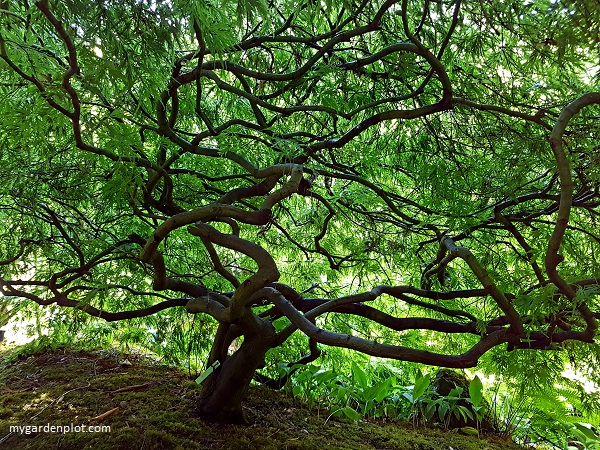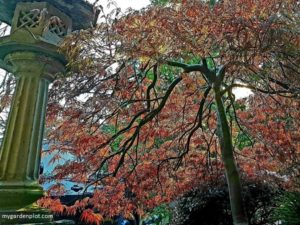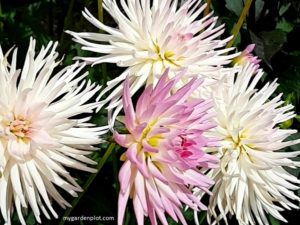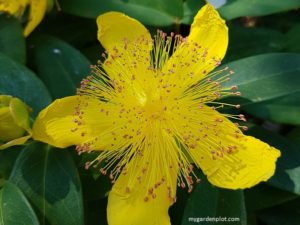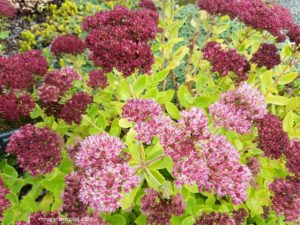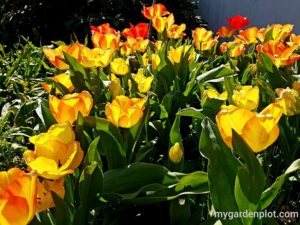About Japanese Maple Trees: Acer palmatum and A. japonicum
Selected for their beauty, size and form variations, the Japanese maple tree fits into any garden. They also adapt to various climatic conditions from rainy wet regions like our Pacific Northwest to the Mediterranean’s warmer areas. Differences in form and size, in addition to the variations of foliage colour, put these trees into a superior category. We wholeheartedly agree. And why we wanted this guide on Japanese maple tree care. Tips include how to plant and when to prune them. In our garden, the Japanese maple trees enhance the gardens along with the rhododendrons and azaleas, flowering quince, flowering dogwoods, mock orange, star magnolia and forsythia shrubs.
Japanese Maple Trees Cultivars: Brief History
Native to Japan, Acer palmatum and A. japonicum grow extensively throughout Japan and can be found in most gardens either in the ground or in container gardening, and of course, used for bonsai techniques. The maple tree has a long history in Japanese horticulture. Sadly, many of the old cultivars from the 17-18th century were lost during the two world wars. Today, new varieties continue to be cultivated, and the keen interest in Japanese maples trees has extended worldwide. And indeed, in the Pacific Northwest, they have become prevalent in many gardens, including ours. Currently, there are hundreds of different Japanese maple tree cultivars.
The name ‘Japanese maple tree’ has been used commercially as a catch-all. Often these are grouped cultivars originating from Acer palmatum and A. japonicum (also referred to as Full Moon Maple). But occasionally, the term includes other cultivars that are not common in Japan.
Read more about Acer palmatum var. dissectum. Also known a the Weeping Japanese Maple or Laceleaf Japanese Maple Tree. Providing care tips how to grow, maintain and prune a weeping or laceleaf Japanese maple tree. As well as recommended varieties for your garden.
Japanese Maple Trees Variations
The Japanese maple tree has a fantastic range of form, leaf texture and sizes. Their forms includes widespreading, upright and rounded open forms. And there is a size for every garden from small trees, to over 9 metres (30 feet). Most are slow-growing, which makes it manageable and low maintenance. For instance, a tree measuring 9 metres in height could take around 50 years to reach that big.
The foliage of greens, reds, or variegated leaves turn to stunning fall colours of reds, orange, and yellow hues, making them extremely popular as either a companion plant or an ornamental tree. And their leaf form varies in shape and size.
Japanese Maple Trees At A Glance
Type: Deciduous Tree or Shrub
Location: Full Sun to Part Shade
Seasonal Interest: Spring Foliage, Summer Foliage And Winged Seeds, Autumn Colour, Winter Stems
Size: Varies from 1 metre (3 feet) to 9 metres (30 feet) – see additional note below on height
When To Prune: Mid / Late Winter (see details below)
Plant Hardiness Zones: 5, 6, 7, 8, 9
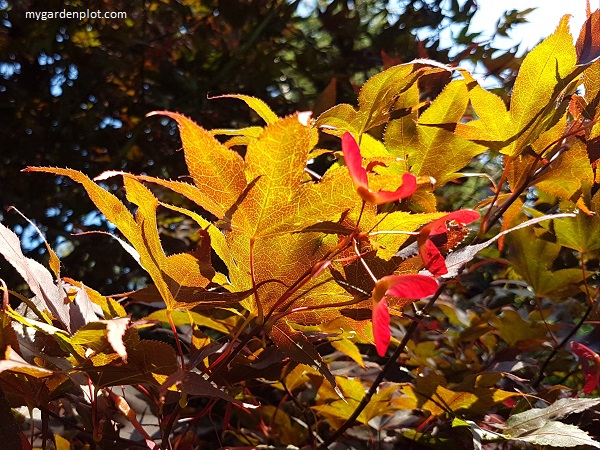
Size Of Japanese Maple Trees
The height of either Acer palmatum and A. japonicum in excess of 9 metres (30 feet) is ultimately subject to growing conditions and location attributes. Additionally, the Japanese maples’ Dwarf group can grow to 2 metres (6.5 feet), while those in the Dissectum group can grow to 5 metres (16 feet) at maturity. The Dissectum group represents Japanese maples with deeply dissected leaves, such as the weeping Japanese maple tree (laceleaf Japanese maple).
Some Japanese maple cultivars are well suited for container gardening, such as from the Dwarf group. Some Japanese maples, not necessary from the Dwarf group, are especially suitable for bonsai, which is a specialized technique where a tree or shrub is planted in a shallow container and trained to resemble its full size as if grown in its natural habitat.
Where To Plant And Grow Japanese Maple Trees
Japanese maple trees are adaptable to various soil conditions but thrive in moisture-retentive acidic soils. They prefer cool summers. And while some cultivars can tolerate full sun, especially the green varieties, their leaves can be prone to sunburn during scorching hot summers. Planted in a site with sun dappled afternoon shade can prevent this.
- See Acer palmatum var. dissectum (Weeping Japanese Maple / Laceleaf Japanese Maple Tree) for specific growing tips on this cultivar.
Some Japanese maple trees are suitable for container gardening and can remain happy for many years without repotting or root pruning. Ours has been happy in the same large ceramic pot for over 15 years. The root structure of Japanese maple trees have a lot to do with their adaptability to different sites. They have a root network that stays mostly close to the soil’s surface, rather than reaching deep down. As the tree matures, it will grow its roots deeper but not extensively.
When planting your new tree, ensure the hole is wide enough to encompass the root mass. Like rhododendrons, it does not need to be planted deeply. Mix into the soil rich organic compost and some bone meal. This will help the young tree to establish quicker.
How To Care For Japanese Maple Trees
Most Japanese maple trees like regular watering, but do not let it get waterlogged. Ensure the site is well-draining. Don’t wet the leaves too much during hot summer months, as it can aid in leaf parching. Always best to water early morning. Established maples during summer should be watered at least twice a week as with a regular irrigation schedule. However, maples from the Dwarf group can adapt to dryer conditions such as alpine gardening.
For the Japanese maple tree planted in a pot, use its own leaves from fall drop to add a loose layer of protective mulch for the winter.
In spring, add a mulch layer to help retain moisture with all Japanese maple trees, whether planted in the garden or in a container. This also helps keep weeds down. Japanese maple trees do not need a lot of fertilizing. Lightly mix in into the mulch a balanced slow-release garden fertilizer (like a 10-10-10) yearly. This should be enough for a healthy Japanese maple tree.
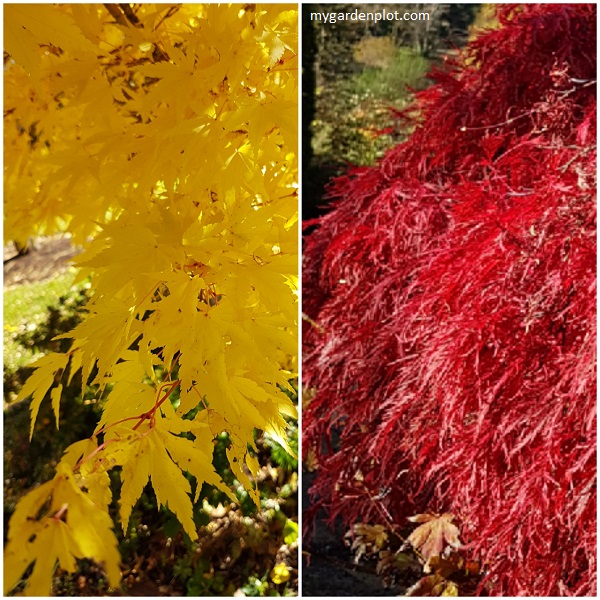
RELATED TOPIC: Buyer’s Guide How To Choose Garden Hand Pruners (Secateurs)
How To Prune Japanese Maple Trees
One of the beautiful features of the Japanese maple tree is the stem structure of twisting or cascading branches. Which can’t be seen if it is allowed to get too bushy. Pruning and shaping is needed to bring out those dramatic effects in the Japanese maple tree.
All major remedial pruning or shaping should be done in winter during the dormant time of the tree. Scheduling this annually goes a long way in keeping the tree looking good. Routine maintenance should include removing damaged stems and corrective pruning. Cutting off deadwood can be done at any time of the year. When pruning, always remember to clean pruning tools to limit any spread of diseases.
Tools Needed For Pruning Japanese Maple Trees
Below is the list of essential tools needed to prune a Japanese maple tree:
- Pruners – Bypass pruners are the most popular choice for gardeners and a must in a pruner’s tool kit. Bypass means the blades pass each other in a scissorlike action providing a clean cut without splintering the stem’s edge. The anvil-type pruner, where the upper blade cuts against a lower flat edge, must always be kept sharp. Otherwise, it will crush the stem while trying to cut it. Pole pruners are also very handy to have especially when pruning taller trees without a ladder.
- Long-handled Loppers – These are similar to pruners but with long handles. Loppers are heavy-duty and great for harder to reach stems that may also be too thick for pruners. Shop for an extendable lopper for the extra reach.
- Pruning Saw – Saws are useful for thick stems that are growing close together. A Grecian saw or Japanese-blade pruning saw is a handsaw with a curved or straight edge that works with a pull-stroke action. Great for those stems that pruners and loppers can’t cut. It will need a protective case. We also recommend a folding hand saw with a pull-stroke action for smaller gardens. It looks similar to a large pocket knife and works in the same manner as a Grecian saw.
- Garden Gloves – Gardening gloves help keep hands clean and provide protection. Fabric gloves with vinyl offer a good grip on the fingers and palm. Good for warmer weather. For more challenging jobs, a pair of suede or leather gloves go a long way. Not too comfortable in warmer weather, though.
RELATED TOPIC: Buyer’s Guide How To Choose A Pruning Saw (Garden Handsaw)
Pests And Diseases
Thankfully, Acer palmatum and A. japonicum are usually trouble-free from problems. Occasionally, the usual garden culprits, like aphids, mites or leafhoppers, can sometimes spoil leaves’ appearance. Weevils can damage the roots of young plants. Other problems such as verticillium wilt, anthracnose, or powdery mildew can occasionally affect the tree.

